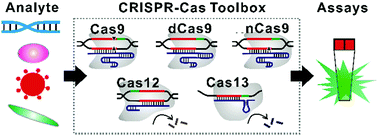The CRISPR–Cas toolbox for analytical and diagnostic assay development
Abstract
Clustered Regularly Interspaced Short Palindromic Repeats (CRISPR) and CRISPR-associated (Cas) systems have revolutionized biological and biomedical sciences in many ways. The last few years have also seen tremendous interest in deploying the CRISPR–Cas toolbox for analytical and diagnostic assay development because CRISPR–Cas is one of the most powerful classes of molecular machineries for the recognition and manipulation of nucleic acids. In the short period of development, many CRISPR-enabled assays have already established critical roles in clinical diagnostics, biosensing, and bioimaging. We describe in this review the recent advances and design principles of CRISPR mediated analytical tools with an emphasis on the functional roles of CRISPR–Cas machineries as highly efficient binders and molecular scissors. We highlight the diverse engineering approaches for molecularly modifying CRISPR–Cas machineries and for devising better readout platforms. We discuss the potential roles of these new approaches and platforms in enhancing assay sensitivity, specificity, multiplexity, and clinical outcomes. By illustrating the biochemical and analytical processes, we hope this review will help guide the best use of the CRISPR–Cas toolbox in detecting, quantifying and imaging biologically and clinically important molecules and inspire new ideas, technological advances and engineering strategies for addressing real-world challenges such as the on-going COVID-19 pandemic.



 Please wait while we load your content...
Please wait while we load your content...